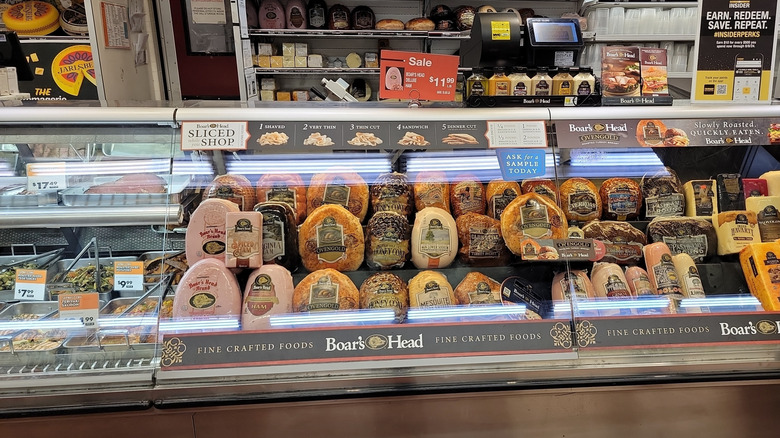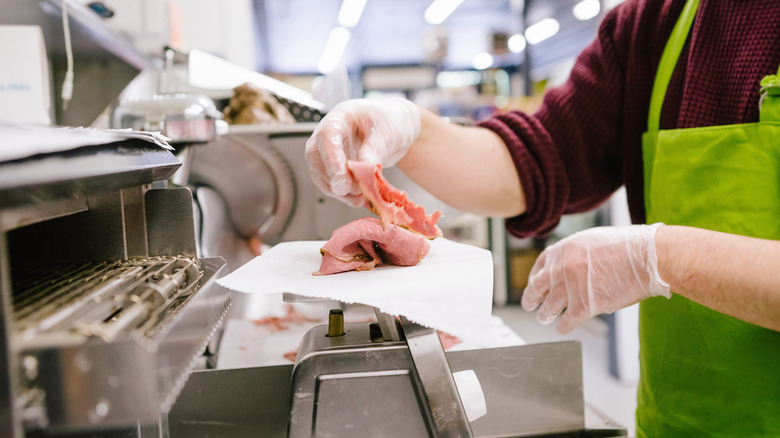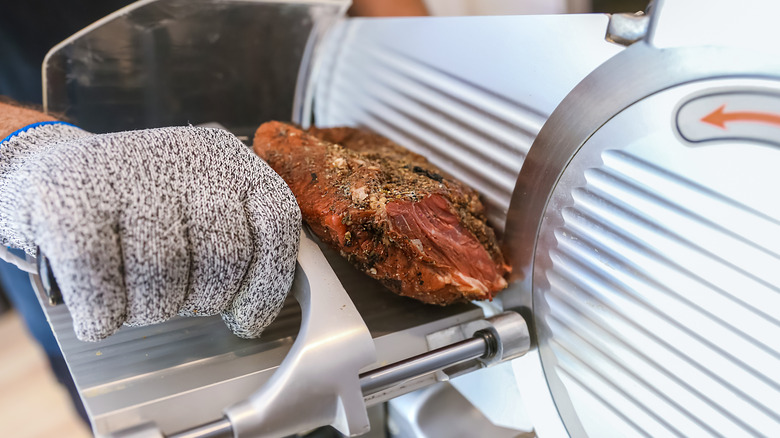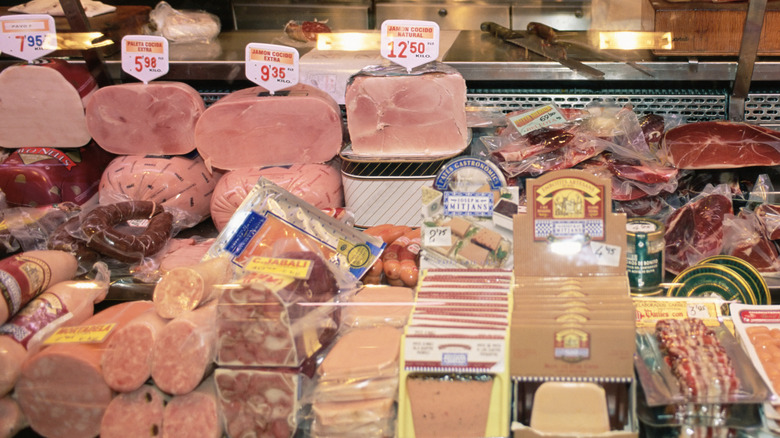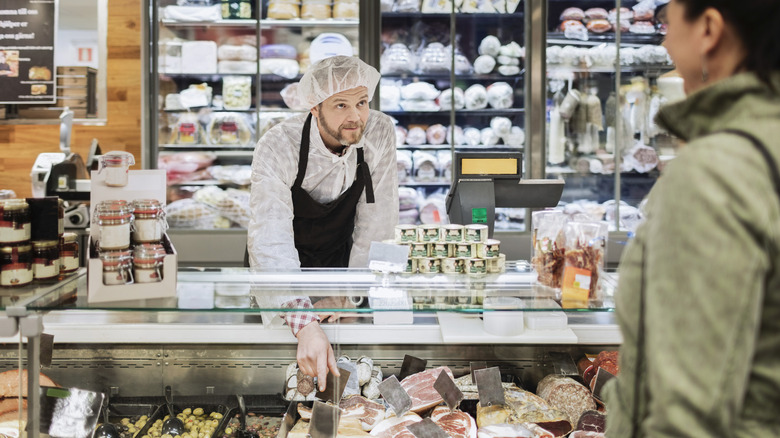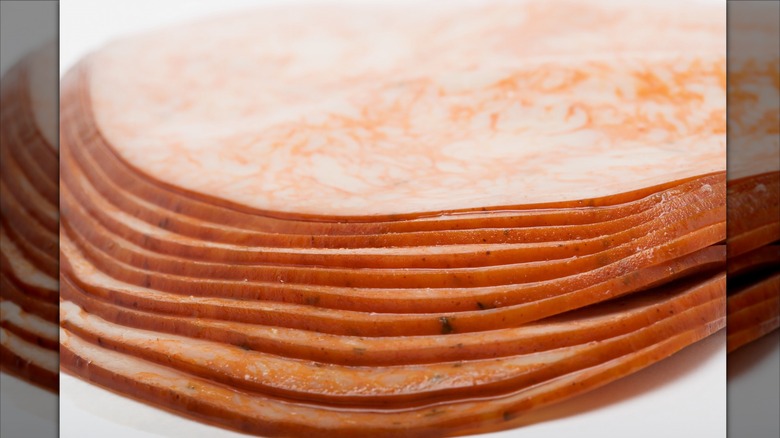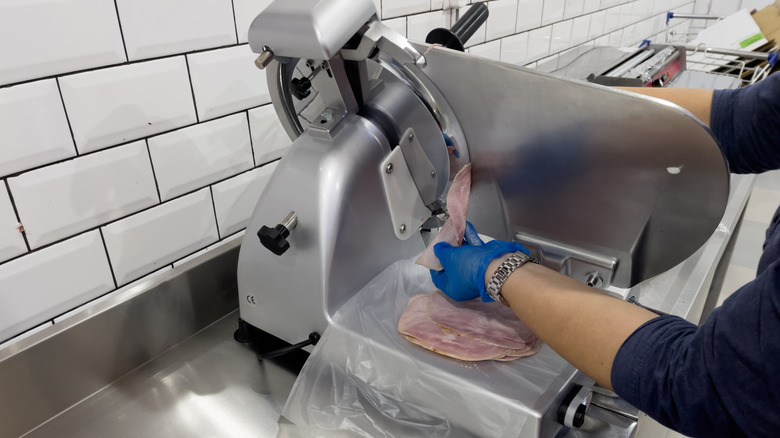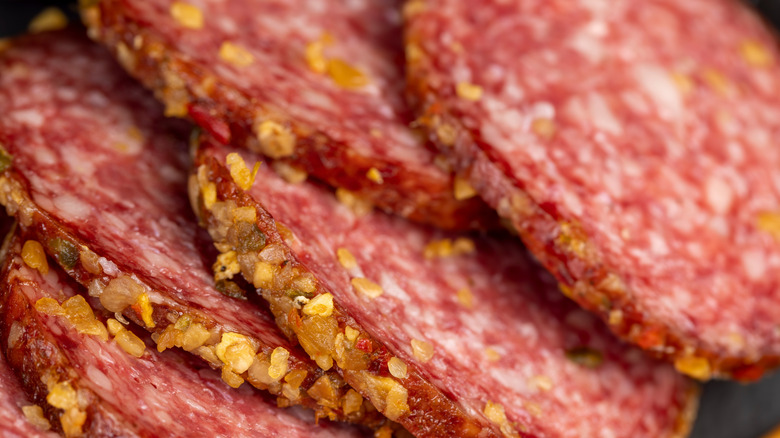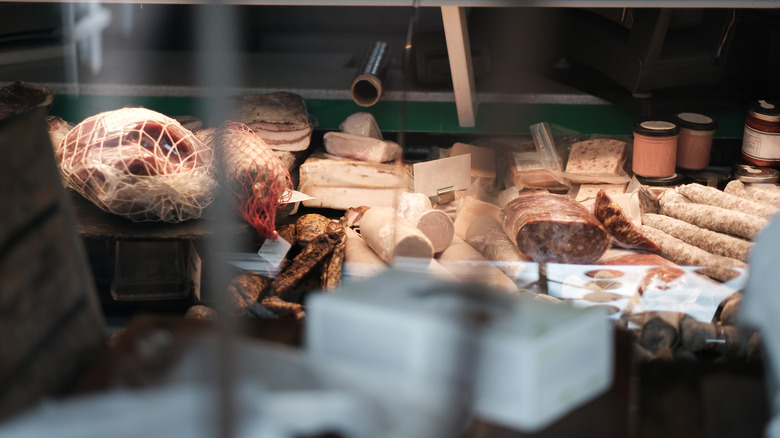10 Mistakes You Make When Ordering At A Deli
A delicatessen traditionally refers to a specialty grocer selling a wide variety of cheeses, cold cuts, salads, imported foods, and other prepared dishes. Originating in Europe, the concept of these delis was eventually brought over to the United States, where Americans developed a fondness for these specialized counters providing sliced-to-order proteins and the like. Nowadays, it's rare to find a U.S. grocery store without a deli department standing at the ready to slice, dice, and assemble its various meat and cheese offerings. Throngs of standalone delicatessen shops are sprinkled from sea to shining sea as well — see our list of the some absolute best delis across the country. Given the inherent popularity of delis, chances are, you've requested a pack of sliced pastrami or a mouthwatering Italian sub sandwich from that deli down the street a time or two (or 10) ... but no matter how deep your experience runs, mistakes can still be made in the process of ordering from a deli.
Using insight from deli workers and customers posting online, we've assembled a list of some of the most common mistakes made at the deli counter by both seasoned delicatessen-ordering patrons and newbies alike ... and some of them will have you re-thinking your upcoming lunch order. From inaccurate weights to unknown cuts to obscure deals, here are 10 mistakes people make when ordering at a deli.
1. You ask for your sliced meats in weight rather than by number of slices
Ordering a pack of meat from a deli can feel a bit intimidating. What is the correct way to ask for your desired amount of sliced turkey, ham, or bologna? Should it be done according to weight or by total number of slices? And will you be making a fool of yourself if you opt for one over the other? Rest assured, either weight or slice number can be used to specify your desired amount of deli meat, and no one behind the counter will mock you for the method with which you choose to communicate your order. However, deli workers across online threads insist that, if choosing between the two, asking for an overall slice total is superior for a number of reasons.
First, instructions for a specific number of slices are more straightforward for the deli clerks because they involve zero math, calculation, or weighing. Secondly, that eliminates the potential for misplaced or unrealistic expectations from the customer's standpoint. Workers admit that patrons do not always have an accurate understanding of how many slices make up a certain weight — leading to disappointment and even do-overs in some situations. To increase your chances of getting your needed amount of meat correct the first time (and to make things easier on the person behind the counter), consider cutting right to the chase and requesting the number of slices wanted during your next deli order.
2. You don't ask for adjustments on slice thickness
Why does roast beef taste different from the deli? It's all about using a good cut of meat. Another part of the appeal of ordering sandwich meat and fillings at a deli, as opposed to purchasing pre-cut packs found in the store, is having the ability to customize the thickness of the individual slices to your liking. Whether you prefer your roast beef shaved thin or kept hefty, the choice is yours ... or, at least, it's supposed be.
Unfortunately, however, not every customer leaves the deli counter satisfied with the width of their sliced meats and cheeses. Some shoppers report feeling intimidated or nervous when it comes to requesting an adjustment in thickness if they're unhappy after sampling a slice at the counter — and, as a result, will sometimes settle for a cut they dislike rather than speaking up and risking offending anyone.
According to online forums, however, there's no need to be afraid to request that the slicer be adjusted after tasting your sample. It's all part of the process, and making changes is an anticipated part of a worker's day in regard to providing customer satisfaction. "The purpose is to see if you like the thickness," said one commenter on Reddit about the reason behind handing out free samples. "Those slicers are adjustable so don't feel rude. If it's too thin for you, ask for a thicker slice. It's their job."
3. You request whole, uncut pieces of meat
We've all seen the huge uncut slabs of honey-glazed ham, seasoned chicken breasts, or peppered turkeys hanging out behind the deli case glass, waiting to be sliced and packaged. However, if you're serving a crowd or crafting a dish requiring larger chunks of meat, you may have wondered whether or not you're able to skip right over a slicing order and go straight for the purchase of the entire hock. While deli employees assure that yes, shops will often sell you a whole chunk of meat upon request, there is one thing to keep in mind: It may not be the most economical purchase.
Workers admit that while it is usually possible to buy uncut pieces of meat from a deli, it isn't a great deal from a financial standpoint. This is most likely due, in part, to the fact that whole chunks are generally going to be priced according to weight — and any gristle, fat, bones, and other potentially unusable bits will contribute to that number on the scale. Having a skilled deli clerk present you with a stack of professionally sliced, thick cuts composed of usable meat is probably going to be your best bet in obtaining a quality protein that simultaneously provides the greatest bang for your buck.
4. You point to, rather than specifically name, the item you want
It just comes naturally — when we see an item we want in a glass display case, we point to it. But while pointing out that tub of potato salad, hunk of classic American cheese, tasty-looking sub sandwich, or delicious briny pickles at your local deli may be a perfectly clear action from your perspective, things aren't so clear cut for the person working behind the counter.
According to some workers online, it's nearly impossible for them to see exactly what clients are pointing to from the other side of the glass. This, naturally, may lead to them asking you to specify — an action that can slow the order process and cause the line behind you back up farther than it would have if you had simply named your desired item from the get-go. On the other hand, if the employee makes their best guest on what it is you're pointing out and gets it wrong, this will also back things up. You'll have to politely inform them of the miscommunication, and the worker must go back in for the correct item. To prevent misunderstandings and be respectful of the time of both the employees and the customers behind you, remember to work in a verbal cue when you point out the deli meat brands made with high-quality ingredients that you want.
5. You're asking for thickness based on the counter's visual guide
For patrons who have no idea where to start when it comes to asking for cuts, many delis will provide a visual guide for ordering — usually, a collection of five or six pictures with an assigned name indicating each cut's level of thickness. Whether it's shaved, very thin, or standard thin you're after, following these visuals will steer you in the direction of selecting your perfect slice of meat ... or so you thought.
According to workers, deli visuals can sometimes be misleading, as there are more settings to a slicer machine than most guides suggest. One person on Reddit addressed this on a post featuring a snapshot of the Boar's Head slicer guide, stating: "They [customers] also don't realize that I can slice it at any thickness from see-through to a couple inches, there's not just 5 settings." This comment was echoed others, who describe similar incidents in which guides have negatively affected customers' experiences and satisfaction. One person who said they worked at Walmart explained, "We have 2 separate slice size guides and neither of them properly display how thick/thin the slicers actually go." The moral of the story? The visual above the counter doesn't necessarily tell all when it comes to slicing options. If you're wanting something outside the parameters of the display guide, simply ask the deli clerk.
6. You're not taking into account the slicer gauge when requesting cuts
Since many deli counters come with a visual photo guide assigning a number to a certain width of a cut, it follows that one would be expected to name that same number when specifying their preferred thickness. Interestingly enough, however, you may want to cease calling out the "1" or "3" you see on the slicer guide going forward with your orders. Some deli workers online have said, in a rather bizarre twist, that the numbers on deli visual guides do not always match up with the numbers on the slicer machines themselves.
Disparities between numbers assigned to cuts on guides and numbers on slicer machines mean that a patron who requests a number "4" cut, for example, may potentially receive an order featuring slices that are thicker or thinner than they were expecting. This is because that in some deli shops, the number "4" setting on the slicer will reportedly produce a different-sized slice than the number "4" photo on the board — and if the employee misunderstands which "4" you are referring to, you've got an order mishap on your hands. If you're planning on using the visual guide as a benchmark for your dream slice thickness, just make sure to specify that the photo represents the width you're after so as to avoid any misunderstandings — and subsequent sandwich disappointment.
7. You don't know about the dinner cut
If you're an experienced deli connoisseur, you probably think you've got all of the best cuts memorized and stored away in the back of your mind for your various meaty needs. Shaved so you can build the perfect charcuterie board? Check. Sandwich cut for a lunchtime BLT? Of course. But what about the dinner cut for a main course entrée?
Little do some consumers know, there is a lesser-known, extremely thick cut available from many delis that is known as the dinner cut. These slices, which are reminiscent of the giant slabs of meat found in old-fashioned TV dinners, can be used in a variety of dishes. Looking for a low-maintenance protein to serve on Thanksgiving that requires zero cooking or slicing on your part? Grab a pack of dinner-cut turkey breasts and whip up some homemade gravy to drizzle on top. Seeking some flavor-inducing protein to throw into that sizzling stew recipe? Hit up your local deli and have the workers behind the counter package you up some dinner-cut ham hunks. Do yourself a favor and place this particular underrated cut in your knowledge bank for later — at some point, your deli-meat-craving stomach may thank you.
8. You aren't ordering ahead of time
When it comes to placing an order from the deli, the process is pretty straightforward. Walk up, grab a ticket (if your local deli is still using the classic ticketing system, that is), and tell the person working the counter what you want. That's it — no ifs, ands, or buts, right?
As it turns out, there is actually a "but" in regard to the typical deli-ordering procedure. According to some meat counter workers and shoppers across online platforms, many delis allow customers to call and place an order ahead of time rather than requiring them to stand in line to do so. Providing a prior heads-up and a pickup time is actually preferred and encouraged when it comes to larger orders. It can also be useful for the everyday consumer hoping to cut down on their wait time at the counter — similar to placing a takeout order from a fast food restaurant. Orders can typically be placed in advance via phone, text, or website, depending on the individual shop. Go ahead; try it out the next time you're wondering how on earth you'll make it back to the office in time for that post-lunch meeting with the deli sandwich you've been craving in hand. You're welcome.
9. You're requesting your aged cheese be sliced too thin
Meats aren't the only items traditionally waiting behind the counters at delicatessens. It is common for a wide variety of hard, soft, and aged cheeses to be up for grabs from these specialty markets, available for slicing and packaging, or to be cut and added to individual made-to-order sandwiches. Whether your desired dairy is brie, cheddar, mozzarella, camembert, or gouda, you should be able to request a perfectly paper-thin slice to be applied to the culinary creation of your choice, the same way you are able to with the meats. Right?
Wrong, unfortunately. Just because delis can slice everything thin, doesn't mean they should. And in the case of cheese, the deli clerk's ability to execute a beautifully shaved slice is highly dependent on the type you're requesting. Aged cheeses, such as Swiss or a good sharp cheddar, will usually crumble if cut too thin. In some cases, they may even clog up the slicer machine itself — a major pain not only for you, but also for customers in line behind you and the employee charged with cleaning it out. Asking the knowledgeable worker behind the counter whether slices, wedges, or other shapes are the most realistic for your preferred type of dairy treat can help you avoid any unpleasant cheesy disasters in the future.
10. You aren't asking about the end cuts
Let's face it: Delis harbor a bit of a reputation for being consistently expensive when it comes to sliced proteins. If you've given up any and all hope of finding a steal on roast beef or prosciutto at your local delicatessen, then perhaps it's time for you to stop and consider the end.
No, really — we're talking about the end cuts, the best-kept secret of a deli near you. According to a savvy customer on a Reddit thread under r/EatCheapAndHealthy, some grocery store delis offer up assorted packages of the less-desirable end pieces of different types of finished meat logs at an extremely discounted rate. Others on this thread admitted that their shops offer up similar steals on discard cheese ends, or on near-to-expiring bits and pieces of ham, chicken, or turkey. You can, it seems, find deals at a delicatessen, after all. All it takes is a little bit of knowledge regarding your local shop's processes and procedures, some willingness to step outside the box ... and a taste for sliced meat, of course.
